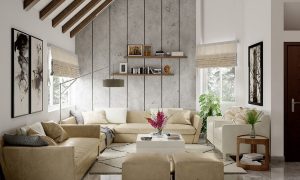Textures in Decor: The Subtle Power of Tactile Design

When it comes to interior design, textures play a crucial role in creating a visually appealing and inviting space. While colors and patterns often take center stage, the power of tactile design should not be underestimated. Adding different textures to your decor can elevate the overall aesthetic and bring a sense of depth and warmth to any room.
The Importance of Texture
Texture refers to the surface quality of an object or material. It can be rough or smooth, soft or hard, and can be experienced through touch or visual perception. Incorporating different textures into your decor can significantly impact the ambiance and atmosphere of a space.
Textures have the ability to evoke emotions and create a tactile experience for those in the room. They add depth and dimension, making the space feel more visually interesting and dynamic. By appealing to both the sense of sight and touch, textures can create a multi-sensory experience, enhancing the overall design aesthetic.

Using Texture in Decor
There are various ways to incorporate texture into your decor, whether it’s through furniture, fabrics, or accessories. Here are a few ideas:
- Textured Walls: Instead of plain, smooth walls, consider adding texture through wallpapers, textured paint, or wall panels. This can create a focal point in the room and add visual interest.
- Layered Fabrics: Mixing different fabrics such as velvet, linen, or wool can add depth and richness to your decor. Use textured throws, pillows, or curtains to create an inviting and cozy atmosphere.
- Natural Elements: Incorporating natural materials like wood, stone, or woven fibers can add a rustic and organic texture to your space. Consider using wooden furniture, stone countertops, or rattan accessories to bring the outdoors inside.
- Patterned Tiles: Tiles with interesting patterns and textures can be used on floors, walls, or backsplashes to add visual texture and create a statement in the room.
- Art and Sculptures: Three-dimensional art pieces or sculptures can add texture to your decor while also serving as a focal point. Consider incorporating sculptures made from materials such as metal, glass, or ceramic.
The Impact of Texture on Different Spaces
The impact of texture can vary depending on the room and its purpose. For example:
- Living Room: In the living room, incorporating plush and soft textures can create a cozy and welcoming atmosphere. Use textured rugs, cushions, and upholstery to make the space feel inviting.
- Bedroom: In the bedroom, textures can add a sense of luxury and relaxation. Opt for soft and silky bedding, textured headboards, or plush carpets to create a serene environment.
- Bathroom: In the bathroom, textures can add a spa-like feel. Consider using textured tiles, pebble flooring, or natural stone countertops to create a soothing and calming atmosphere.
Remember, when incorporating textures into your decor, it’s important to maintain a balance. Too many textures can create a cluttered and chaotic look, while too few can make the space feel bland and uninteresting. Experiment with different textures and find a balance that suits your personal style and the overall aesthetic you want to achieve.
Textures in decor have the power to transform a space, adding depth, visual interest, and a sense of tactile experience. By incorporating various textures into your design, you can create a unique and inviting atmosphere that reflects your personal style and enhances the overall ambiance of your home.








